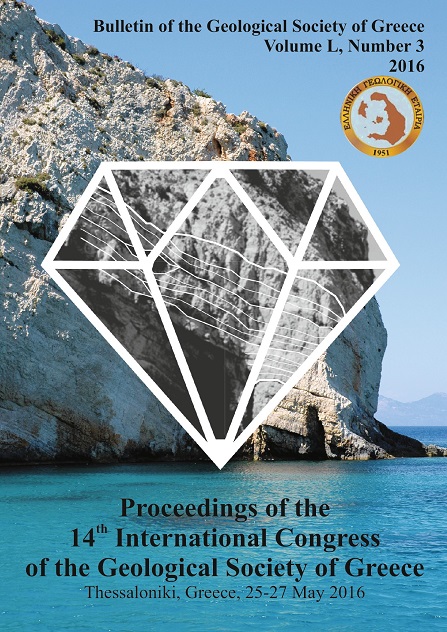Detailed archaeomagnetic study of a ceramic workshop at Kato Achaia: New directional data and archaeomagnetic dating in Greece.
Περίληψη
Στην παρούσα εργασία παρουσιάζονται τα αποτελέσματα από την αρχαιομαγνητική μελέτη δυο αρχαίων κλιβάνων που ανακαλύφθηκαν στην Κάτω Αχαΐα. Σύμφωνα με τα ευρήματα της αρχαιολογικής ανασκαφής, οι δυο αυτοί κλίβανοι αποτελούσαν μέρος ενός μεγαλύτερου κεραμικού εργαστηρίου που λειτουργούσε στην περιοχή, πιθανότατα για την παραγωγή τούβλων ή κεραμικών. Συστηματική αρχαιομαγνητική δειγματοληψία πραγματοποιήθηκε σε συνεργασία με τους αρχαιολόγους και συνολικά λήφθηκαν 9 δείγματα από τον πρώτο κλίβανο (KL3) και 12 από τον δεύτερο (KL5). Συστηματικές μετρήσεις της μαγνητικής ορυκτολογίας των δειγμάτων πραγματοποιήθηκαν με σκοπό τον καθορισμό του βασικού φορέα της μαγνήτισης των δειγμάτων. Η διεύθυνση της Χαρακτηριστικής Παραμένουσας Μαγνήτισης καθορίστηκε κατόπιν ανάλυσης της κύριας συνιστώσας μαγνήτισης και οι μέσες τιμές διεύθυνσης για τους δυο κλιβάνους υπολογίστηκαν σύμφωνα με την στατιστική του Fisher. Η ηλικία των κλιβάνων υπολογίστηκε χρησιμοποιώντας τις πιο σύγχρονες εξελίξεις στην αρχαιομαγνητική έρευνα και κατόπιν σύγκρισης της διεύθυνσης των XLVII, No 3 – 1279 κλιβάνων με τις καμπύλες αναφοράς, όπως αυτές υπολογίστηκαν από το SCHA .DIF .3K γεωμαγνητικό μοντέλο που περιγράφει την μεταβολή του μαγνητικού πεδίου στον Ευρωπαϊκό χώρο. Τα αποτελέσματα της αρχαιομαγνητικής χρονολόγησης συμφωνούν πολύ ικανοποιητικά με τις αρχαιολογικές ενδείξεις για την περίοδο χρήσης των κλιβάνων και υποδεικνύουν ότι οι κλίβανοι ήταν σε χρήση κατά την διάρκεια της ελληνιστικής περιόδου και εγκαταλείφτηκαν προς το τέλος αυτής.
Λεπτομέρειες άρθρου
- Πώς να δημιουργήσετε Αναφορές
-
Tema, E. (2013). Detailed archaeomagnetic study of a ceramic workshop at Kato Achaia: New directional data and archaeomagnetic dating in Greece. Δελτίο της Ελληνικής Γεωλογικής Εταιρείας, 47(3), 1279–1288. https://doi.org/10.12681/bgsg.10903
- Ενότητα
- Γεωφυσική και Σεισμολογία

Αυτή η εργασία είναι αδειοδοτημένη υπό το CC Αναφορά Δημιουργού – Μη Εμπορική Χρήση 4.0.
Οι συγγραφείς θα πρέπει να είναι σύμφωνοι με τα παρακάτω: Οι συγγραφείς των άρθρων που δημοσιεύονται στο περιοδικό διατηρούν τα δικαιώματα πνευματικής ιδιοκτησίας επί των άρθρων τους, δίνοντας στο περιοδικό το δικαίωμα της πρώτης δημοσίευσης. Άρθρα που δημοσιεύονται στο περιοδικό διατίθενται με άδεια Creative Commons 4.0 Non Commercial και σύμφωνα με την οποία μπορούν να χρησιμοποιούνται ελεύθερα, με αναφορά στο/στη συγγραφέα και στην πρώτη δημοσίευση για μη κερδοσκοπικούς σκοπούς. Οι συγγραφείς μπορούν να: Μοιραστούν — αντιγράψουν και αναδιανέμουν το υλικό με κάθε μέσο και τρόπο, Προσαρμόσουν — αναμείξουν, τροποποιήσουν και δημιουργήσουν πάνω στο υλικό.




